Impact of Biomedical Waste on Cuttack City
Puspalata Pal1 * and Dhirendra Kumar Sarangi2
1
Ravenshaw Government Jr. College,
Cuttack,
India
2
Department of Zoology,
J.K.B.K. Government College,
Cuttack,
India
DOI: http://dx.doi.org/10.12944/CWE.13.2.11
Copy the following to cite this article:
Pal P, Sarangi D. K. Impact of Biomedical Waste on Cuttack City. Curr World Environ 2018;13(2). DOI:http://dx.doi.org/10.12944/CWE.13.2.11
Copy the following to cite this URL:
Pal P, Sarangi D. K. Impact of Biomedical Waste on Cuttack City. Curr World Environ 2018;13(2). Available from: http://www.cwejournal.org?p=1080/
Download article (pdf)
Citation Manager
Publish History
Select type of program for download
| Endnote EndNote format (Mac & Win) | |
| Reference Manager Ris format (Win only) | |
| Procite Ris format (Win only) | |
| Medlars Format | |
| RefWorks Format RefWorks format (Mac & Win) | |
| BibTex Format BibTex format (Mac & Win) |
Article Publishing History
| Received: | 2018-02-24 |
|---|---|
| Accepted: | 2018-07-02 |
| Reviewed by: | 
 Dr. Tateda Masafumi (Japan)
Dr. Tateda Masafumi (Japan)
|
| Second Review by: |

 Dr. Alex Godoy-Faúndez (Chile)
Dr. Alex Godoy-Faúndez (Chile)
|
| Final Approval by: | Dr. Umesh Chandra Kulshrestha |
Introduction
The infectious biomedical waste which is only 15 to 25% of the entire waste is not segregated and is mixed with general waste which ultimately turns the whole waste into infectious waste.3 The same waste is dumped into municipal bins and in municipal dumping yards , then, therefore the whole wastes in municipal bins become infectious and the mixed wastes in open dumping yards make the environment filthy and hazards to the public spreading dangerous diseases.
The unethical disposal of mixed waste containing sharps, needles and anatomical wastes from surgeries cause injuries,cuts and various of nosocomial infections and transmission of diseases like hepatitis B. hepatistis C, HIV etc. among the hospital staff,
municipal workers, waste handlers, rag pickers and general public.4 The reuse of needles, syringes and other articles by the patients not only worsens ones conditions but also but also take someone to the threshold of death. Careless and unethical dumping facilitates the poor and destitute who are encouraged by some traders to collect such waste which subsequently come to the market with repacking and selling .One of the reasons for spreading of infection is reuse of disposable items like syringes,needles,catheters IV and dialysis set etc (Tamplin et al 2004). The dumping of untreated biomedical waste in open in Cuttack City enhances the chances of survivals, growth and alteration of pathogenic microbial population which leads to various types of communicable diseases, soil and ground water pollution. Chances of vectors are high like rodents,worms,mosquitoes,flies,stray dogs
getting infected or becoming carriers which also spread diseases among public. Studies show that every year since 2012 the slum dwellers of Cuttack City residing in the Mahanadi river and Taladanda canal side are suffering from various communicable diseases. The residents nearby Krusak Bazar, Bidanasi where the municipal dumping yard is located is also vulnerable to infectious diseases. Other diseases like Jundice is also found every year in Jobra area of the city due to contamination of water. Various studies shows that the effects of used infected syringe and needle by patients are prone to HIV ,Hepatitis B, hepatitis C and other blood borne diseases.
The objective of the present study is to assess the biomedical waste management situation of Cuttack City and its impact on the city dwellers and environment. There are seven government run hospitals and large number of private nursing homes, clinics and diagnostics centres which generated huge quantity of biomedical waste. But lack of proper management and indiscriminate disposal of these wastes are the cause of concern for the inhabitants.The study also highlights the health impact of pharmaceutical wastes,chemical waste, cytotoxic/
genotoxic drugs, waste sharps, radioactive waste and uncontrolled burning of infectious biomedical waste for which the city inhabitants are suffering from various kinds of air and water borne diseases every year.
Definition of Biomedical Waste
According to the Biomedical waste (Management & Handling )Rules 1998 of Govt of India “Biomedical Waste means any waste which is generated during the diagnosis, treatment or immunisation of human beings or animals or in research activities pertaining thereto or in the production or testing of biological, including categories mentioned in Schedule-1 (Table-1) appended to these rules “ 1,2. It is clear from the definition that Biomedical waste comprises both human & animal anatomical waste, treatment apparatus like needles, syringes and other materials used in health care facilities in the process of treatment and research. These wastes are generated during diagnosis, treatment or immunisation in hospitals, nursing homes, pathological laboratories, blood bank, etc. (Table-gives the type of waste generated from different generation points.
 |
Table 1: Category of Biomedical Waste and its treatment and disposal options 1,2,3
Click here to view table |
Step-1(a)Pre chemical treatment for Disinfection at source. (b) Microwaving/Autoclaving followed by mutilation shredding Step-2-(a)Final disposal in deep & secured landfill by authorised registered agency(b) Disposal of plastics/glass/polythene by authorized registered agency.
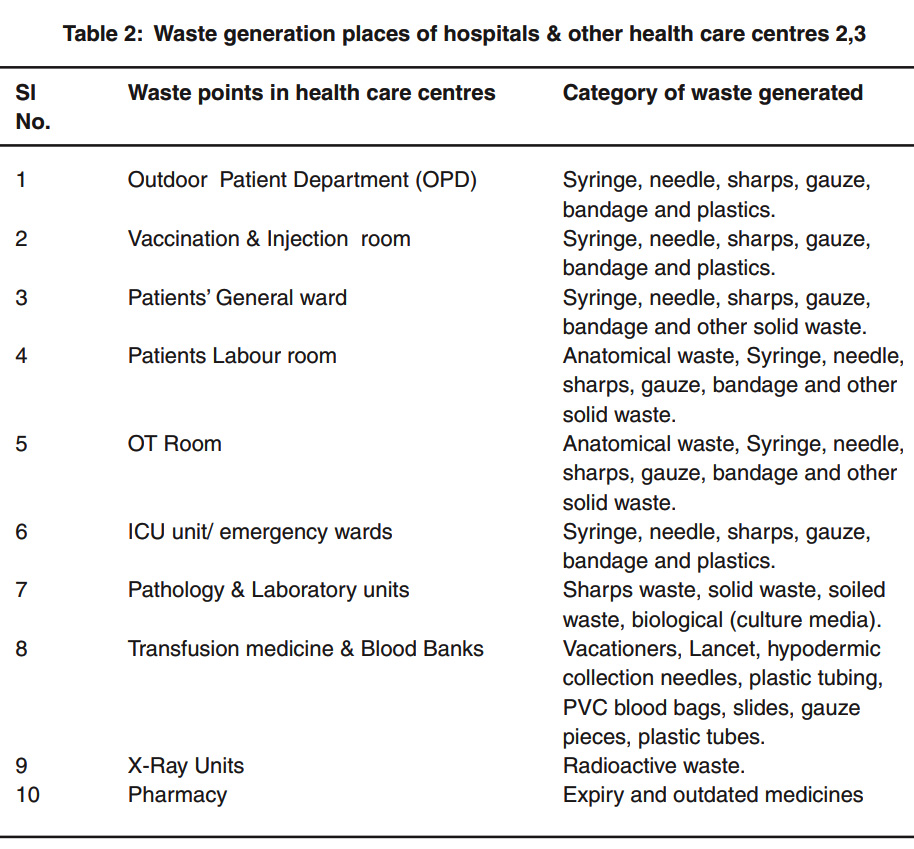 |
Table 2: Waste generation places of hospitals and other health care centres 2,3. Click here to view table |
Problems and Risks from Biomedical Waste and its need for safe management4,5,7
- Infectious wastes containing possible harmful microbes can infect patients, patients’ attendants and health care personnel.
- Used needles, syringes, and other sharps present in biomedical waste cause risks of injury and infection for health care staff.(for example, hepatitis B and C, and HIV
- Intoxication or injuries such as burns from chemical and pharmaceutical wastes.
- Mutagenic and carcinogenic properties of genotoxic wastes which are hazardous and have harmful effects.
- W astes from radioactive sources may cause terrible injuries to human beings such as tissue damage.
- Untreated liquid wastes from health care facilities contaminates ground and surface water and spreads water borne diseases like jaundice and cholera.
- Careless disposal of BMWs in open dumps increase the risk of injury from sharps and the spread of infectious diseases to house keeping staff, waste handlers, scavengers and the public.
- Open and uncontrolled burning of biomedical waste increases the risk of exposure to hazardous emissions.
- Environmental and health risks to local residents and incinerator operators due to poorly designed or operational biomedical waste incinerators as it emits carcinogenic dioxins and furans, formed through incomplete combustion at low temperatures.
- Harmful effects of untreated medical equipments and recycled products from biomedical waste.
- Untreated and carelessly managed solid and liquid biomedical waste is vulnerable to air, water and soil causing pollution.
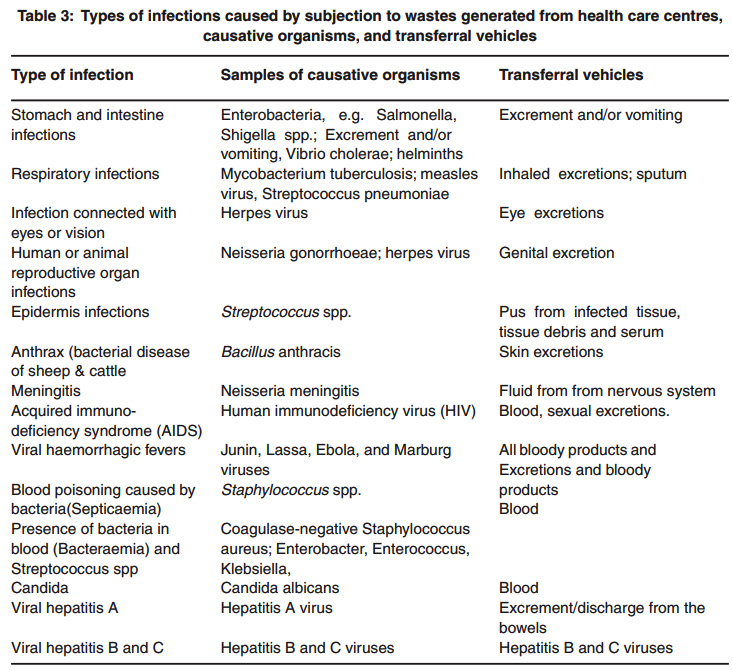 |
Table 3: Types of infections caused by subjection to wastes generated from health care centres, causative organisms, and transferral vehicles.
Click here to view table |
Impacts of infectious waste and sharps
The highest rate of disease transmission usually comes from infectious biomedical waste and sharps which mostly include syringes and needles. The highest rate of injuries are also found among staff during the use of sharp material and its subsequent disposal. The prime threat is the transmission of HIV virus, Hepatitis B and C through cuts and injuries caused by syringes contaminated with blood.4,6
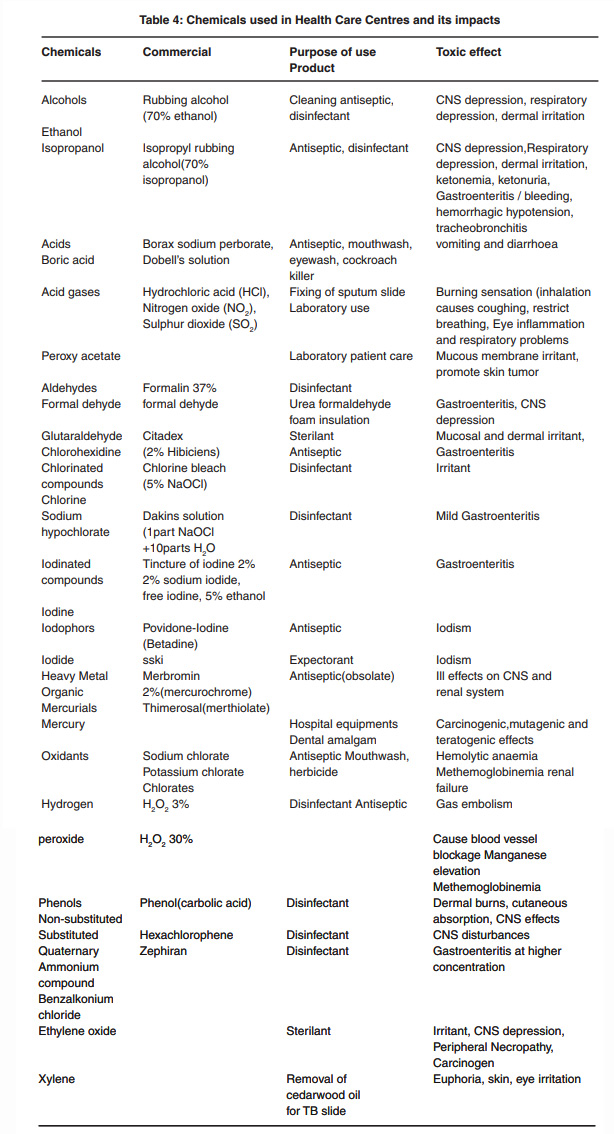 |
Table 4: Chemicals used in Health Care Centres and its impacts
Click here to view table |
Studies show that more than 50% nursing personnel usually are more prone to needle stick injury whereas other medical staff like attendants,house keeping house keeping staff,laboratory technicians, pharmacists and other paramedical staff together come across rest of the needle stick injury during their medical duty.4,5,7
Impacts of chemical and pharmaceutical waste
Hospital staff like Pharmacists, anaesthetists, nursing sisters, house keeping and maintenance staff are more prone to respiratory or skin diseases caused by chemical or pharmaceutical waste substances like fumes , aerosols, liquids, solvents from disinfectant X-Ray film, chemotherapeutic or anti cancer drugs, outdated medicines and smokes from incinerators. Some hazardous chemicals used in health care facilities are also carcinogenic and pose health risks to hospital workers,patients, and community.4,6
 |
Table 5: Pollutants from crude burning and Low temperature waste incineration of Bio medical waste and their toxic effects |
Impacts of genotoxic waste
Direct contact or exposure to genotoxic materials have serious consequences on human health and environment as it is carcinogenic and mutagenic. It causes mostly skin and eye diseases. Contact like mouth pipetting, preparation during drug therapy,contact with the bodily fluids, secretions of patients undergoing chemotherapy, ingestion of food contaminated with cytotoxic drugs and chemicals have also harmful effects like dizziness, nausea, headache or dermatitis.4,5,7
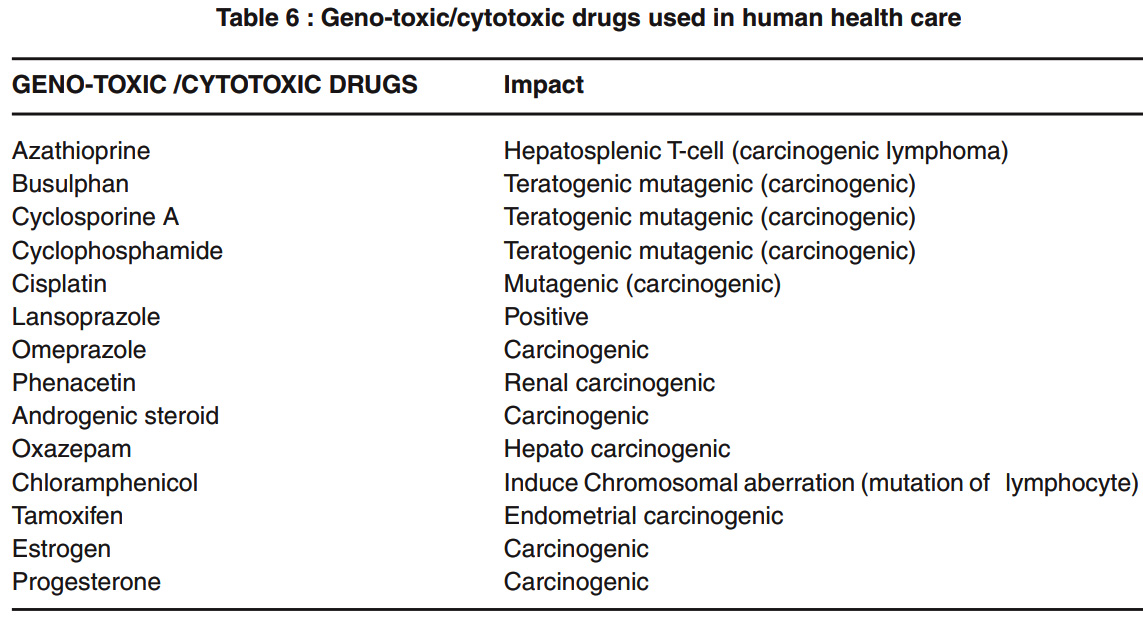 |
Table 6: Geno-toxic/cytotoxic
Click here to view tabledrugs used in human health care |
Impacts of Radioactive Waste
Infected or contaminated radio nucleides generated from in-vitro analysis of body tissues and fluid, unscientific and improper handling of radiotherapy solutions,unsafe management of X-Ray instruments, unscientific disposal of nuclear therapeutic materials,exposure and access to ionizing radiations in health-care centres and radioactive waste etc. have serious health impact.8
Biomedical Situation Of Cuttack City
Cuttack is one of the oldest city in India and second largest corporation in the state of Odisha with a total population 606.007 individuals as of the 2011 census. Spread across an area of 298 sq km, the city of Cuttack is situated at the apex of the Mahanadi River Delta and is located about 28 km north of Bhubaneswar, the capital of Odisha Cuttack City is the former capital of Odisha and the current headquarters of Cuttack district. The city is popularly known as the Health Hub of eastern India. There are seven major specialized government hospitals in Cuttack City and according to the Chief District Medical officer.
Cuttack there are also 229 registered and more than 300 unregistered Nursing Homes, Clinics, Pathology and Diagonostics centres which generated huge quantity of biomedical wastes. Bio-medical wastes include human anatomical waste like tissues, organs, body parts, as also animal waste, microbiological and biotech-nological waste, hypodermic needles, syringes, scalpels, broken glass, discarded medicines, dressing’s bandages, catheters, incineration ash, etc.2 The Biomedical waste management practices in the city is highly deficient and grossly neglected. The wastes get mixed up with municipal solid waste and deposited at the common disposal site. The Cuttack Muncipal Corporation is not collecting Biomedical waste from the health care centres. Rather some agencies are engaged to collect biomedical waste specifically from the seven government run hospitals and taken the waste to the common waste treatment facility where the biomedical waste are not managed in scientific manner. Despite media campaign and judicial inspection to the major government hospitals of the city, there still exist missing links that have serious implications for both human health and urban ecology of Cuttack.
Present status of biomedical waste management of hospitals, nursing homes, clinics, pathology and diagnostic centres of Cuttack city.
Improper and unscientific management of Biomedical waste handling and management is an emerging issue in Cuttack City which is surrounded by Mahanadi and Kathajodi river as there is large number of hospitals, nursing homes, clinics, pathology and diagnostic Centres presence across every lanes of the city. Solid biomedical waste(both clinical and non-clinical) generated from these health care centres except some Govt and private hospitals are collected in open bins without disinfection. Though colour coding bins are kept for different categories of waste but no segregation and improper collection of wastes are noticed during my survey except a few private and govt Hosptals. Rather sorting of used disposables for reuse are found without disinfection. Rag pickers are also collecting these dangerous waste for reselling ultimately spreading infections. It is also noticed that used plastics, glass, intravenous sets, bottles, sharps, syringes are sold to third party. Some wastes are also found in the Muncipal bins in various places of the city. These infectious wastes are transported by the waste collector by hand-held cart to Muncipal dumping yard and are found to be disposed on road side /open pits without safety precautions. Open burning of these wastes in the Mahanadi and Kathajodi river and Taladanda canal side cause air pollution and toxic ash. No fencing is noticed in the dumping yard to keep the rag pickers away causing serious health impacts. People very often raising their concern due to unsafe disposal of these wastes, unaesthetic conditions, odour nuisance and ground water pollution of the area. Table-7 gives untreated and unsegregated biomedical waste found in open bins in various locations of the city.
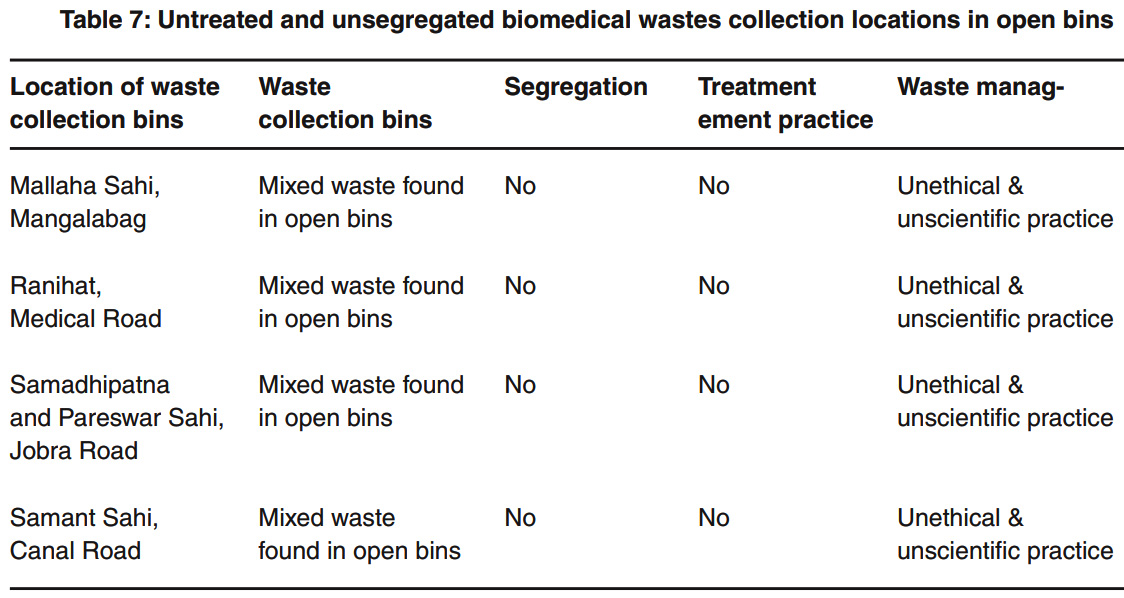 |
Table 7: Untreated and
Click here to view tableunsegregated biomedical wastes collection locations in open bins. |
Similarly infectious liquid waste are flown to the septic tanks, open drains and to the nearby Taladanda canal and Kathojodi river around the city which cause health concerns to the city residents. Very often the drains are found over-flowing and in precarious conditions. Every year the city is in the headlines of the news paper and electronic media for spreading of various diseases due to contamination of water and air. The New Indian Express reported on 18 February 2018 that 43 persons, including 31 from Jobra’s Samadhipatana and Pareswar Sahi and 12 from Nuapada, were suffering from the water-borne disease. Unofficial sources, however, put the figure at much higher as patients continued to pour in at hospitals from different part of the city. Use of contaminated drinking water due to leakage in pipelines coming in contact with the infected liquid waste is suspected to be the cause behind resurgence of the disease. The Deccan Herald reported on February 2015 the outbreak of jaundice in Cuttack City. The New Indian Express also reported on 3 January 2014 the jaundice and cholera outbreak in the city. The Times of India on 13 January 2017 and The Hindu on 28 February 2017 reported about 100 jaundice cases in Tulsipur area of the city. In Table-8 provides location of infectious liquid waste flown and residents affected in the area suffering from jaundice and cholera in 2017.
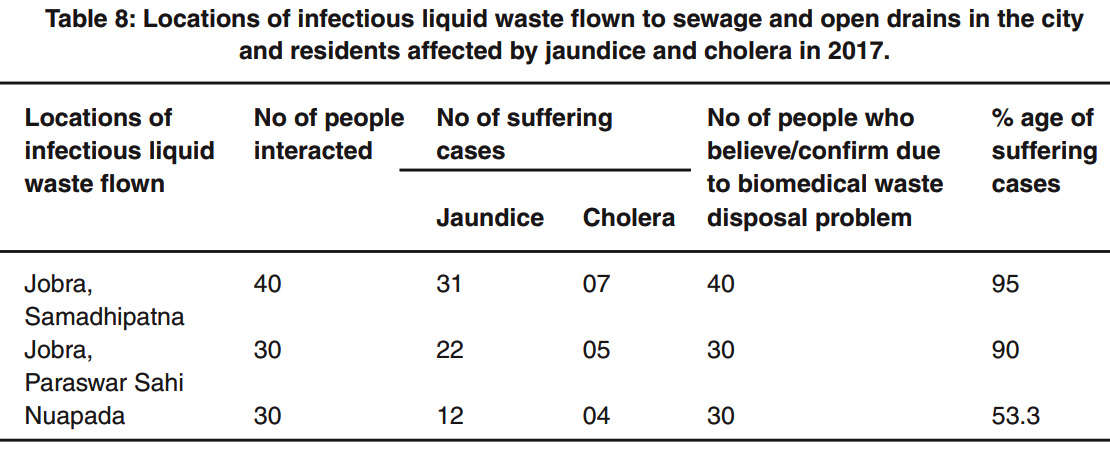 |
Table 8: Locations of infectious liquid waste flown to sewage and open drains in the city and residents affected by jaundice and cholera in 2017
Click here to view table |
Discussion
During the study it was noticed that all the health care institutions of Cuttack city some way or other were not following the rules prescribed by the authority and manage these hazardous waste at their own will putting public life and environment into danger for which the inhabitants are continuously suffering from various kinds of epidemics and transmittable diseases every year. Despite enactment of time to time legislations and framing of rules for scientific management of biomedical wastes for clean and green environment,but the health care institutions of the city are not following the guidelines and facing irreparable loss and damage to human and environmental resources.
As biomedical wastes are not properly handled and carefully managed, the city is always in the news for spreading of dengue fever, jaundice and other diseases most of the time in a year. Many hospitals and health care centres in the city handed over the waste to private parties or even dumping them in the municipal garbage bins despite provisions to entrust the management to an authorized agency to handle the hazardous biomedical waste. Both general and infectious biomedical waste were found in the bins kept in the premises of hospitals and health care centres indicated that wastes were not segregated in different colour coded bins as per the law and these institutions were openly violating the biomedical waste management rules in Cuttack city. Biomedical Waste (Management & Handling) Rules, 1998 of Govt. of India provided a regulatory framework for management of biomedical waste generated in the country. Subsequently Govt. of India reviewed the rules and amended it in the year 2000, 2003, 2011 and 2016 for the proper implementation of these rules more effectively and to improve the collection, segregation, processing, treatment and disposal of these biomedical wastes in an environmentally sound manner reducing its generation and impact on the environment. But during the study it was revealed and found that most of the hospitals and health care centres are not serious about implementation of the biomedical waste management rules and admitted that either they are handing over the waste to private agency or dumping the waste in municipal bins. The study also found the effect and impact of indiscriminate disposal of pharmaceutical wastes, chemical waste, cytotoxic / genotoxic drugs, waste sharps, radioactive waste and uncontrolled burning of infectious biomedical waste on residents for which the city inhabitants are suffering from various kinds of air and water borne diseases every year.
Conclusion
Prior to 1998,before the enforcement of Biomedical waste management rules in India, usually the hospials wastes are either dumped or disposed of with the municipal wastes in landfills which led to spread of HIV, hepatitis B virus (HBV) and other contagious diseases which raised public awareness and concerns about proper and scientific disposal of biomedical waste. As per law, medical waste is required to be treated and managed in a scientific manner suggested for different categories of wastes and not to be mixed with municipal waste at any cost. Therefore Cuttack City which generates huge quantity of biomedical wastes needs special attention for proper scientific biomedical waste management solution to safeguard the environment and healthy living conditions for the inhabitants.
Acknowledgments
The present research was carried out and supported by the authors of this paper. We deeply thank to our colleagues, staff and well wishers who supported their expertise and experience in providing insight to this work that assisted the research. W e thank to staff of Hospitals, Clinics, Nursing Homes and working personnel of waste management agencies who provided us support in conducting the field study and survey for the research work.
References
- Biomedical W aste (Management and Handling) Rules 1998, Ministry of Environment and Forest, Government of India and as amended : (http://envfor.nic.in/ legis/hsm/biomed.html)
- Biomedical W aste Management Rules 2016, Ministry of environment, forest and climate Change, Government of India Rules. 2016.
- National Guidelines on Hospital W asteManagement Based upon the Bio-Medical Waste (Management and Handling) Rules, 1998, New Delhi: MoHFW ; 2002 Government of India, Ministry of Health and Family Welfare (MoHFW).
- Impact of Biomedical Waste on City Environment: Case Study of Pune, India. www.iosrjournals.org
- Pruss, E. Giroult, P. Rushbrook, .Safe management of waste from health-care activities, W HO Library Cataloguing-in-Publication Data, 1999.
- Li, C., Fu-Tien, J., Physical and Chemical Composition of Hospital Waste, Infection Control and Hospital Epidemiology. 14(3):145-1993.
CrossRef - Bdour, A. 2004 Guideline for the Safe Management of Medical, Chemical, and Pharmaceutical W aste. National Institute for Environmental Training, Riyadh, Saudi Arabia.
- Silva, C.E., Hoppe, A.E., Ravanello, M.M. & Mello, N. 2005 Medical waste management in the south of Brazil.






